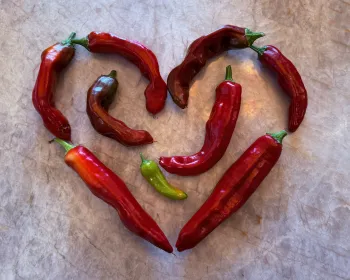Pasting and Saucing Chile Peppers: Exploring Flavors from New Mexico to Peru (November 2025)
Robyn Barker, UC Master Food Preserver Online Program Volunteer
If you have a sunny spot in your garden or on your patio, chili peppers are fun and easy to grow. The plants don’t get too large; they can even be grown in a container. They are relatively disease and pest free. With limited space and energy though, I prefer to grow varieties that I like to eat but can’t be easily found at the grocery store. This year, among others, I grew Hatch and Aji Amarillo varieties.
Hatch peppers are synonymous with New Mexico. I’ve heard said that, just as sparkling wine must be from the Champagne region of France to be Champagne, a Hatch pepper must be from New Mexico to truly be a Hatch pepper. Whether you visit Albuquerque or Santa Fe, these peppers will be found in a myriad of dishes: chiles, cheeses, tacos, burritos, or my favorite, a Hatch chili cheeseburger. In the late summer and fall, they sell bags of fire-roasted Hatch chilis by the side of the road. I bought my seeds in the spring, and they were labelled as producing a mild green chili.
Aji Amarillo peppers are from Peru. Aji is the Spanish word used for chili peppers in South America; amarillo means yellow. The peppers are fruity and tangy and moderately spicy, about 30,000 to 50,000 on the Scoville scale. Like the Hatch peppers in New Mexico, they appear in many Peruvian dishes, most deliciously in Aji de Gallina or Peruvian Chicken chili. When fully ripe, they are a neon orange color and they are about the last of my chili peppers to ripen (Fig. 1). It isn’t unusual for me to be biting my nails hoping they will ripen before the weather gets too cold.

Aji Amarillo peppers in various stages of ripeness (Photo caption: Robyn Barker, used with permission).
Early fall is about the right time of the year to process Aji Amarillo peppers. It’s a little late for my Hatch peppers, which I didn’t catch before they turned red (Fig 2). I frequently wait for my jalapeno and serrano peppers to turn red – the flavor tends to be richer and fruitier and a bit hotter. But not all peppers improve with age. The shishitos become too dry, and the pulp of these Hatches seems to have thinned. But they are still usable!

Ripe Hatch peppers (Photo caption: Robyn Barker, used with permission).
I decided to preserve some of my peppers so I could keep a little of the summer flavor to enjoy later in the winter. Both preparations can be used to make dips, marinades, or spice up sauces and soups. Although I made these sauces with the Hatch and Aji Amarillo peppers, the instructions will also work with many other varieties of chili peppers that you find in the grocery store produce section, your farmers’ market, or in your garden.
To prep the chili peppers, first slice off the stem and blossom ends and remove the seeds and the white pith. Use disposable gloves to protect your hands from the spicier peppers.
To keep the sauce smooth, remove the skin of the peppers. This can be done after blanching the peppers in boiling water, but, preferring the smokier flavor, I put them under a broiler for five minutes until they started to blister and blacken and then let them steam in a plastic bag or under tented aluminum foil for ten minutes. The skin then comes off easily (Fig 3).

Roasted Aji Amarillo pepper that has been skinned (Photo caption: Robyn Barker, used with permission).
To make a paste with the Aji Amarillo peppers, I whirled them in my food processor with about a tablespoon of water until they were pureed. I then filled slots in an ice cube tray and put the tray into the freezer (Fig. 4). Each cube slot held about two tablespoons of puree. Once frozen, I can repack the cubes into a plastic freezer bag or vacuum-sealed bag, labelling them so I will remember exactly what they are, and use them as needed. You can find several recipes that rely on the Aji Amarillo paste. I’ve yet to try them, but am intrigued by:

Aji Amarillo paste being loaded in ice cube tray (Photo caption: Robyn Barker, used with permission).
- Aji de Gallina: https://kitchenjoyblog.com/aji-de-gallina-peruvian-yellow-pepper-chicken/
- Dipping sauce: https://www.platingsandpairings.com/aji-amarillo-recipe/
- Peruvian Style Mahi Mahi: https://greenhealthycooking.com/peruvian-style-mahi-mahi-recipe/
I decided to make a more complicated sauce or salsa with the Hatch peppers because their mild flavor wasn’t quite so distinctive. This sauce can be kept in the refrigerator for up to a week or frozen for 6-month to a year.
Hatch Pepper Sauce
Makes about 1 cup
15 minutes prep time
½ cup roasted Hatch chili peppers
1 Tbsp olive oil
½ yellow onion chopped
2 cloves garlic, minced
¼ cup roughly chopped cilantro leaves and stems
½ lime, zested and juiced
2 Tbsp cider vinegar
1 Tbsp honey
½ tsp salt
- Heat olive oil in a small skillet over medium high heat. Add the onions and sauté until soft and translucent, stirring occasionally for five minutes. Do not brown. Stir in the garlic and sauté until fragrant, 30 seconds.
- Transfer the onion mixture to a food processor. Add the hatch chiles and pulse 8-10 times.
- Add the chopped cilantro, lime zest, lime juice, cider vinegar, honey and salt. Purée until smooth
- This sauce can be frozen in freezer-safe containers (be sure to leave room for expansion), frozen using the ice-cube tray technique described in the Aji Amarillo recipe above, or kept it in the refrigerator for up to a week.
Adapted from https://www.garlicandzest.com/hatch-green-chile-sauce/
